Abstract
This study has aimed to scrutinize the emergence and progress of the roles of online marketing for Heritage Visitor Attractions in Malta by coordinating with the national economy, local market trends, and ICT skills of the human resource by taking into account customer’s motivation to the new technology. With this objective, this study has aimed to formulate a better understanding of the online marketing of HVAC that would assist the operators and regulating authorities to systematize better policy towards a greater motivation for online marketing in Malta compared to the global standard.
List of abbreviations
- Archaeological Society Malta = ASM
- Cultural Heritage Advisory Committee = CHAC
- European Commission = EC
- European Travel Commission = ETC
- European Union = EU
- Fondazzjoni Patrimonju Malti = FPM
- General Agreement on Tariffs and Trade = GATT
- Heritage Malta = HE
- Heritage Visitor Attractions = HVAs
- Hewlett-Packard = HP
- Malta College of Arts, Science and Technology = MCAST
- Malta Communications Authority = MCA
- Malta Environment and Planning Authority = MEPH
- Malta Information Technology Agency = MITA
- Ministry for Tourism and Culture = MEPA
- National Heritage Advisory Committee = NHAC
- Ramblers Association Malta = FAM
- Return on Investment = ROI
- Superintendence of Cultural Heritage = SCH
- World Economic Forum = WEF
- World Trade Organization = WTO
Introduction
This dissertation will represent the implementation of online marketing in the tourism industry of Malta for its Heritage Visitor Attractions with a comprehensive analysis of the online marketing performance of the Maltase Information Technology enabled companies based on their current position as well as traditional practice in this sector. This dissertation with the online marketing of HVAs in Malta will be organized with six major chapters and concerned sub-chapters that would ultimately assist the research to attain its conclusion through an analysis of the background problem, search for literature review with appropriate research methodology along with result and findings.
Background of the problem
Hussein (2010) pointed out that to generate tourist’s motivation towards a heritage site; information is the powerful tool to deliver exact data to the customer regarding the unique, intangible, and complex tourism products where the customers are interdependent, isolated, and comes from the diverse location. The characteristics of tourism products are very complex and dependent on the time, place, and human factors where customers are not familiar with the reality and the service providers have huge gaps of communication and interaction with the service seekers (Farsari & Prastacos, 2004). In the present era of Information and Communication Technology, web-based free flow of information has provided greater than ever the opportunity to make up these gaps through the web presence of the service providers and also by online marketing as well as e-Commerce. With very marginal cost and fewer efforts than traditional marketing, online marketing has facilitated the tourism industry to provide exact information to the visitors and attract them to the heritage tourism that would assist in planning and booking for a visit towards any particular site from all over the world (Veverka 2012; and Argyropoulou, Dionyssopoulou & Miaoulis 2013).
The Movie Channel (2013) pointed out that Valletta, the capital of Malta has gained the twentieth position out of 962 HVA sites all over the globe for its World Heritage Sites ranked by UNESCO for its outstanding universal value to the global tourism industry. There are three iconic HVA sites in Malta such as the City of Valletta, Hal Saflieni Hypogeum, and Megalithic Temples of Malt, which drawn special attention by UNESCO and gained superior importance to the tourism industry of the country with superior tourist appeal globally due to listing them as a world heritage site. According to the Movie Channel (2013) Valletta, the capital of Malta is the second-highest demanded tourist spot for US visitors for its rare urban inhabited sites surrounded by the little peninsula and 320 monuments and perfection of its conservation of the historical attachment of the ancient era.
Foxell and Trafford (2010), Ortega (2002), and Poria (2001) added that the expansion of the global tourist industry has generated extra pressure on Malta to relocating itself in the horizon of cultural heritage linking with its ancient history of civilization. At the same time, the country has developed its higher extent of environmental awareness to protect Maltese islands and to safeguard the cultural heritages by preventing environmental degradation and implementing appropriate ecological management (Foxell & Trafford 2010). The real-life scenario illustrated although the governmental policy has aligned to invest for the environment, but faced tremendous obstacles from different interest groups due to their narrow business interest while NGOs and environmental activists are keeping continuous pressure for implementation of environmental projects to safeguard its heritage.
The rationale for the Research
The World Economic Forum (2013) presented the global Travel & Tourism Report 2013 where WEF ranked Malta at the 24th position with a score of 4.92 in this year for its tourism competitiveness where Switzerland at the top of ranking with a score 5.66. Malta’s position in the tourism competitiveness index in 2011was at 26th; thus, the country has progressed on a global scale. In the regional ranking of Europe, Malta placed at 17th position for its tourism sector and 14th position for a business environment and human resource including cultural heritage while the ICT infrastructure of the country ranked at 21st position out of 140 countries.
Kanellopoulos, Panagopoulos & Psillakis (2004) and Pullicino (2002) pointed out the implication of the Information and Communication Technologies ICT in the Tourism Industry has re-engineered the traditional business practice in this sector by integrating internet, web services, dynamic database, e-Commerce, and data mining, warehousing, and multimedia communications. Heritage Visitor Attractions in Malta have quickly adopted ICT to deliver tourism information to the interested travelers in scheduling and booking their visit in Malta, which is an effectual infrastructure for online marketing and promotion. In Malta, the authorities of Heritage Visitor Attractions generally appoint online marketing agents to conduct market promotions and to generate sales while the online marketing agents conduct different unethical actions out of their contract. Rather than own marketing effort, appointing online marketing agents to illustrate that the HVAs of Malta have huge gaps and lacking to develop their ICT infrastructure for online marketing. Thus, to overcome this lacking and gaps it is essential to conduct a depth study with” An assessment of the online marketing of Heritage Visitor Attractions in Malta”.
Thus, the rationale for this study is to outline the implementation of online marketing or e-marketing in the business operation of HVAs, its challenges, prospect and developments, and outcomes of the online marketing program instead of traditional marketing and their correlation that would transform the Heritage Visitor Attractions of Malta to turn itself into an outstanding online marketing entry.
Research Question and Objectives
There is enormous research like Darmanin (2011), DAS (2013), and Ghio (2013) have already conducted with the implication of ICT in the business of Malta, especially different model and shape of e-marketing, its magnitude in the economy of Malta, but no research agenda yet has raised with the effectiveness of online marketing for Heritage Visitor Attractions in Malta. The Malta Information Technology Agency (MITA) is eager to consider the competence of the public and private sector to be proficient to automate their business online by using ICT infrastructure to generate a knowledge economy with the prospects to become the top fifth player for e-business in the European region (Darmanin 2011). MITA has announced the strategic plan of the government, the objective of the governmental policy is very enthusiastic and supportive to the citizen, and business communities to provide standard facilities of ICT that would ultimately progress the economic and business reality of the country at a European scale.
Grech (2004), Hoti et al. (2005), and Debattista (2011) evidenced that HVAs of Malta has aimed to respond vigorously to the ICT automation at their business where online marketing and e-Commerce integration has gained top priority, but such motivation has failed to quickly respond to the changing nature of business operation due to lack of appropriate framework and skill development. This research will aim to assess the use of online marketing in Malta’s tourism industry to determine whether it affects the marketing of Malta’s Heritage Tourist attractions. Therefore, the specific objectives of this research will be:
- To define the terms “Online Marketing” and “Heritage Visitor Attractions”
- To establish the relationship existing between online marketing and Heritage Visitor Attractions
- To successfully examine the existing literature concerning Malta’s experience with online marketing on its Heritage Visitor Attractions.
- To identify the supply of heritage visitor attractions in Malta
- To develop and conduct appropriate research methods to identify and explore the effectiveness of different online marketing websites and strategies adopted in Maltese Heritage Visitor Attractions.
- To draw conclusions and recommendations about the potential of online marketing in Malta’s Heritage Visitor Attractions.
The objectives of this research are established in a manner that supports the logical flow of the research. The literature of this will be instrumental in identifying the contemporary issues relating to online marketing of Heritage Visitors Attractions. This will assist in providing a clear guideline for this research by focusing on the influences, trends, and factors applying to online marketing of Heritage Visitors Attractions.
Relevant Literature Review
The Conceptual Framework of Online Marketing
To provide a better understanding of the conceptual framework of online marketing to the readers, this study considers defining different terms, significant features, and aspects strongly accorded with online marketing that would provide a broader perspective to the research project deals with and has presented as follows.
Defining Online marketing
Nowadays online marketing, web marketing, or digital marketing is a popular concept to the business communities to marketing products and services using the internet and other similar tools (Smith & Chaffey 2005; Meier & Stormer 2009; and Doherty, Chadwick & Hart 2003). However, Internet marketing and electronic marketing are different names of online marketing (Hussein 2010, p.27; Doherty, Chadwick & Hart 2003; and El-Gohary 2010). However, contemporary philosophy on this sector considered the Internet as a new channel of distribution since it has both positive and negative function in the business world to the target clients and increase sales revenue (Smith & Chaffey 2005, p.125; Hussein 2010, p.27; and El-Gohary 2010, p.2).
At the same time, Hussein (2010, p.27) stated that online marketing is the process to transfer of products and services from sellers to customers that incorporate one or more electronic method or media; moreover, Smith & Chaffey (2005, p.125) addressed that online marketing includes internet advertising with sponsorship, websites, e-mail marketing, and brand promotions through the Internet and mobile phones. Besides, Hussein (2010, p.27) and Doherty, Chadwick & Hart (2003) argued that online marketing has already integrated all attributes of traditional marketing, such as strategy, product design, marketing mix, distribution, marketing communications, pricing, buyer behavior and so on. As a result, the business organizations all over the world have tried to incorporate Information Technology at the regular business operating system to achieve tremendous success with lower efforts and short deadline (Smith & Chaffey 2005, p.125; Hussein 2010, p.30; Meier & Stormer 2009; and Doherty, Chadwick & Hart 2003).
Features of Online Marketing
Hussein (2010, p.30), Lakhotia (2013), and Meier & Stormer (2009) stated that concurrent literature concentrates on the impact of internet in the marketing and many other related issues, such as functions, theoretical basics and policy, buyer behaviors and the industry perspective. However, it is an effective tool to promote a brand and develop a communication system; however, the following table discusses the features of online marketing.
Table 1: Features of online marketing. Source: Self-generated.
Different ways of Online Marketing
- Website: Speedy and elegant website is the first step of introduction of successful online marketing system for which the tourism organizations and other companies design the effective website to promote the company with other services, such as, provide information about the company and destination, and give online booking facilities;
- E-mail: It is one of the most popular ways for the HVA and traders to communicate with potential customers by sending regular newsletters, message, price quote, extra package, and so on; however, recent studies identified that the marketers are showing reluctance to use it because they can assess the effectiveness of the services;
- Search Engine: Every moment thousands of people connect to the search engines, such as Google, Yahoo, MSN, and many others to get information. Therefore, search engine optimization (SEO) is an effective way of promotion;
- PPC Advertising and Affiliate Marketing: These two methods are effective tools to the marketers for ticket selling and advertising;
Social Media as the most influential Tool for Online Marketing
Most of the marketers of tourism agencies, hotels, and other business organizations conduct online marketing through social networking sites to gain competitive advantages over the competitors of the trade zone (Toolkit 2011; and Evans & McKee 2011). According to Smits and Mogos (2012), social-media device is one of the most admired methods by which businesses can operate successfully and so the use of such mediums are gradually getting more famous for regular-works of numerous businesses, which varies from new or SMC-businesses to giant MNCs; regardless of the widespread use, people are less aware of its impact. The advantages of the second generation of the World Wide Web for networked-businesses comprise lesser expenses, more rapid product-development, and modernization (Brookins 2013; Smits & Mogos 2012; Brown 2010; Engel, Blackwell & Kollat 1995; and Brussee & Hekman 2010).
Moreover, numerous prototypes are built up for assessing and calculating the business-impact of the second generation of the World Wide Web; however, promising-technologies achieve recognition for facilitating collaboration amid firms at trade-networks, while the appliance marketplace continues to prosper (Evans & McKee 2011; Sandilands 2013; Saroj 2012; Shinder 2010; Stelzner 2011; and Toolkit 2011). Smits & Mogos (2012) also noted that there are certain features of corporate capacities, which are affected by Web 2, influencing business-performance; for example, social media has the competence to augment communication and teamwork in corporations, encouraging rapid globalization of corporations, as well as operations; it works by organizing discussions, attaining more individuals quicker, harmonizing schemes and responsibilities, and assessing communication-streams. However, the HVAs of Malta have joined social networking sites to communicate and share information and they take the advantages of social media considering different advantages like the low cost of online marketing.
Malta’s EU Engagement and ICT Progress
Martino (2011) pointed out that Malta’s engagement in the European Union has dramatically strengthened its geopolitical and economical relevance providing strong accord with the European knowledge society that generated a new phase of ICT integration in the regular life of Maltese people and turned into an integral part of EU Digital Agenda Strategy -2020 with remarkable growth. The EC has organized an advisory group named ISTAG that aimed to provide ICT related advisory service to shape research and development to the academia and business of the member states where Malta has strong representation and keeping a vigorous role for strategic agenda and budgetary allocation to progress ICT (Magnússon 2011).
Digital Agenda Scoreboard (2013) mentioned that although at present Malta has a low share in the European ultra-fast broadband connectivity, it has generated uppermost capabilities to the “Next Generation Access”; according to the data of 2012, 99.95% of residences of Malta connected with fixed broadband internet facilities. The country has already attained facilities to provide minimum 30 Mbps download speed to the 99.9% of residences at the next level which 53.8% in the other EU nations, with 49.9% DSL connectivity and 47% broadband cable connectivity, the operators of Malta enjoy higher market share than other EU nations. It has accounted in January 2013 that about population 23.6% of Maltese is enjoying fixed broadband facilities, which is 3.8% higher than the European average although the shared high-speed connections of 30 Mbps were remarkably lower than other European counties, at the same time it also progressed for third-generation mobile connectivity, but the absence of the fourth generation.
Internet Uses in Malta
Digital Agenda Scoreboard (2013) and Pisani (2011) explored that according to the population data of 2011, 66% of the Maltase citizens were the regular user of the Internet, which was 70% in the European average in the same year, and the country is going ahead faster than others are. It has also assessed that 29% of the population has never familiar with the Internet, such disadvantageous population in Europe were 22% in that year; thus, Malta has a long way that it has to overcome within a short period. However, at present there is a 52% population, who use the internet every, from 86% of users are frequently connected irregular basis. The most recent data on mobile use illustrated that 40% of the citizens of Malta access the internet from their mobile phone while in the European region average 36% of mobile users connect to the internet from their mobile device, here Malta has progressed 4% above the European average. Among the commercial concerns of Malta, 40% of them are fully ICT integrated and provided internet facilities to their employees and this rate is 8% below the European average, which is 48%; besides that, it has also illustrated that 60% of Maltese uses internet only for communication purpose just to sending and receiving voice and data. From the rest, 52% of people are using the Internet to reading newspapers and downloading music, and 43% of people are searching academic and business scopes, posing messages in social networks including instant messaging and this rate is 7% higher than the EU average.
Present Position of e-Commerce in Malta
The Times of Malta (2013) reported that MCA and Fsadni & Associates have jointly surveyed with the ICT integration by 700 business enterprises of Malta from seven different business sectors like retail, financial service, manufacturing, communication, construction; community, and tourism to identify the present state of e-Commerce application in the Maltase society. That study identified that in 2012, there were only 14% of commercial entrepreneurs of Malta used e-Commerce as their main marketing and sales channel, but dramatically decreased by 1% in 2013 due to lack of different logistic support including the high cost of recruiting ICT professionals. At the same time, there is a remarkable boost segment of phone sales as the main sales channel, which was 12% in 2012 and 18% in the current year though store visit sales remained almost the same in both years, for instance, 65% and 64% in 2012 and 2013 respectively. Rather than boosting e-Commerce and online marketing, the decline indicates that the ICT application has not well fitted with the product attributes or the marketers were not capable of developing their product fit for customer’s easy access, hosting problem, dilemmas of integrating credit card and third-party payment system for online transaction and lack of programmers.
Among the respondents, 67% of participants were not clear about the role of MCA as a regularity authority of e-Commerce in Malta, although 69% of the businesses have their static website for the last three years, they failed to develop them into dynamic website capable to conduct online marketing and sales. It also indicated that 80% of the entrepreneurs have a computer and an internet connection, but don’t have e-commerce facilities, if there is any technical support from the state agencies it would be possible for a large segment of business to automate their online e-Commerce. In Malta significant progress of partial e-Commerce has marked for online advertising and marketing, huge companies have no e-commerce sites are integrated, but they are using social media such as Facebook and Twitter to boost traditional sales and get a tremendous return for their sales increase in the hospitality, real state and tourism sector.
The Digital Agenda Scoreboard (2013) surveyed the customers of Malta for their familiarity with e-commerce and pointed out that 44% of Maltese in 2011 have purchased some necessary items at least one time online, which is 70% in the Scandinavian countries and remarkably lower than the UE average. On the other hand, it has illustrated that among a total 44% of Maltese online purchases, 38% of people prefer to purchase from the non-national companies of European Union while only 7% purchases commenced from the domestic Maltese sellers, on the contrary, customers of the other EU states commence 41% purchase from the local sellers (DAS 2013).
Tourism Industry in Malta
Noordam and Smid (2002) stated that the tourism sector is one of the three main economic sectors on Malta; however, WTTC (2013) provided concurrent data on this industry, which demonstrates that the direct contribution of the tourism sector to national GDP was about €937.20 million and total contribution of the tourism sector to national GDP was more than €1776.3 million in 2012. According to the report of WTTC (2013, p.5), the direct contribution of the tourism sector to national GDP was about 13.90% while total contribution was near 26.40% in 2012; at the same time, this organization estimated that direct contribution will increase by 2.10% to 3% within next ten years and total contribution will boost by 1.50% to 2.60% from 2013 to 2023. Therefore, the policymakers of this country have already focused on the tourism industry and intended to reach the goal, for instance, the government aims to increase direct contribution (industries that deal directly with tourists) up to € 1,289.70 million and total contribution up to €2,341.70 million by 2013 (WTTC 2013, p.5). However, the following figure shows the total contribution of the tourism segment to the national GDP of Malta-
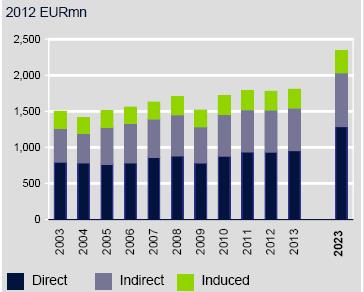
At the same time, WTTC (2013, p.5) reported that the tourism industry has a large impact on the employment segment, for instance, it directly created 25500 jobs (15.10% of total employment) and a total of 45500 jobs (27.20% of total employment) in 2012. Furthermore, the direct contribution of this industry to employment will increase by 1.90% to 31000 jobs within the next ten years and total contribution will enhance by 1.40% to 53000 jobs from 2013 to 2023 (WTTC 2013, p.5). However, the following figure demonstrates the total contribution to GDP and employment in 2012-
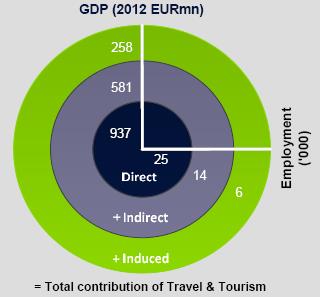
WTTC (2013, p.5) reported that foreign visitors are the main attraction to the tourism organizations since foreigners contribute to generating 82.4% of the total earnings whereas local visitors contribute to generating 82.4% of the total earnings; however, visitor exports are expected to rise by 2.70% in 2013.
According to Hassan & Bashir (2012), at present, tourism is one of the most significant sectors of the economy of Malta because it has a crucial function in output growth, employment market, and foreign exchange generation; however, the following figure demonstrates data related with incoming tourists and income from tourism-
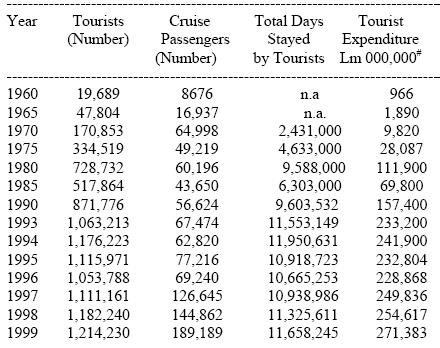
Heritage Visitor Attractions in Malta
SCH (2011) pointed out that the heritage sites of Malta have been planned and managed by a series of consultations with CHAC, NHAC, SCH, and MEPH under the department of planning with direct regulation and licensing of MEPA who formulated different Heritage visitor attractions in Malta with the cooperation of international agencies. Heritage Malta (2007) added that in Malta the HVAs like HE, Din l-Art Helwa, ASM, FPM, St. John’s Co-Cathedral Foundation, RAM and Wirt Għawdex are authorized to for development, promotion, and operations of the heritage sites according to the Cultural Heritage Act-2005 and the HVAs are continuously keeping their effort to promote newer heritage products. The Malta Tourism Authority (2011) and Debattista (2011) mentioned that UNESCO has declared three heritage sites like the City of Valletta, Megalithic Temples, and Ħal Saflieni Hypogeum as world heritage sites that provided more attraction of the global tourism industry, HVAs like Heritage Malta also promoted more heritage sites from it glorious 7000 years history and forwarded for UNESCO reorganization.
Significance of Online Marketing in the Tourism Industry
Hussein (2010, p.127) addressed the general issues of online marketing, importance, challenges, and problems of Internet use by Heritage Visitor Attractions and other related organizations to assess the impact of digital marketing in the tourism industry all over the world. However, Hussein (2010, p.127) further pointed out the view of O’Connor who acknowledged Information as of the “lifeblood” of tourism since it motivates the visitors and customers; most significantly, a quick exchange of information plays a crucial role to reduce the gap between visitors’ travel expectations and actual experiences. Therefore, the online marketing tools became popular to the HVAs and a significant way of promoting and distributing tourism services along with providing accurate information on time; at the same time, visitors use these tools for planning and booking a trip online (Hussein 2010, p.128; Smith & Chaffey 2005, p.125; O’Conner & O’Keefe 1997; and Steinrücken 2010, p.35). In this situation, the travelers get update, inclusive, and relevant travel information; on the other hand, the travel organizations get ideas about the competitors in the national and international market (Hussein 2010, p.128; and Steinrücken 2010, p.35).
However, some issues influence the organizations to integrate ICT to develop the tourism industry, such as
- Demand Creation: Buhalis and Law (2008, p.609) stated that online marketing introduces new trends and transforms customer behavior in the tourism industry since they can get more information and seek exceptional value for money and time; also, Hussein (2010, p.128) stated that tourists become more sophisticated and they seek high-quality products and services. At present, business organizations have greater knowledge about the visitors because online survey allows knowing how tourists select a place to visit considering vacation duration and facilities of the tourist spots, or how the tourists purchase essential products or package services using online service, and so on (Buhalis and Law 2008, p.610; and Buhalis 1998). At the same time, tourists’ interest in the tourist spot with discounted price and satisfaction rate can assess from the survey report; also, HVAs can easily change strategy, develop service, and update websites (Buhalis & Law 2008, p.610; Steinrücken 2010, p.35; O’Conner & O’Keefe 1997; and Hussein 2010, p.131);
- Technological innovation: To provide value-added services to the tourists and increase return on investment, it is essential to ensure an easy transaction system and to inform the customers regarding the facilities with minimum inconvenience. However, tourism organizations need to develop online marketing to develop a direct communication system with the customers since tourists ask fast, convenient and low-cost services, such as make and alter reservations easily, purchase the ticket, provide real-time information on prices and availability (Buhalis and Law 2008, p.610; O’Conner & O’Keefe 1997; Garrod & Wanhill 2012; Steinrücken 2010, p.35 and Hussein 2010, p.132);
- Supply Chain Management: Supply driven literature describes how tourism organization can benefit from online marketing, such as research on how to communicate with buyers and manage distribution channels (O’Conner & O’Keefe 1997; Fyall & Garrod 2005; and Hussein 2010, p.132);
- Industry functions representing demand: Fyall & Garrod (2005) stated that it is very essential in the tourism industry to conduct marketing projects to attract tourists and to help to make decisions by giving information to visit selected destinations.
Importance of Online Marketing in the Tourism Industry of Malta
Briguglio & Marie (1999, p.4), WTTC (2013, p.5), and Noordam & Smid (2002) stated that foreign visitors play a significant role in this industry; however, a greater part of the tourists depend on the internet to access information to get services from the local Travel Agents. However, very few visitors have contacted the experienced visitors to seek assistance or suggestions; current literature demonstrates that tourists prefer to seek recommendation from other visitors with the experience of such HVAs to select or visit a destination (Dodds 2007; Hoti, McAleer & Shareef 2005; Farsari & Prastacos 2004; and Noordam & Smid 2002). Therefore, anticipated visitors check more for online comments, opinions, and preferences to help them reach a sound decision; on the other hand, tourists would like to gather knowledge from other tourists rather than advice from experts. To enhance the online marketing of HVAs, Malta Tourism Authority (MTA) is using the information contained in such online comments and feedback from tourists, user-generated content, and so on (Fedele 2012).
As tourists faced language problem to gather information using the Internet, the Malta tourism industry mostly translates UGC into five different languages, such as English, German, Italian, Spanish, and French; most importantly, these languages represent Malta’s primary HVAs markets; also, parent company collect data and share information with other sister websites and translate information to attract more tourists (Fedele 2012).
Challenges of Online Marketing in the Tourism Industry
According to the literature of Buhalis & Licata (2002), Hussein (2010, p.132), and Vrana & Zafiropoulos (2006), many tourism organizations all over the world have faced severe challenges to integrate or carry on online marketing and web uses to develop business and improve service range. Such challenges include broadband restrictions, security aspects, privacy concerns, social and cultural factors, lack of expert workforce, and so on (Buhalis & Licata 2002; Hussein 2010, p.132; and Vrana & Zafiropoulos 2006). At the same time, the researchers pointed out other challenges to apply online functions, for instance, lack of confidence, different method of communication reduce the importance of human contact, coordination of tasks between suppliers and distributors, and small return on investment due to the small number of bookings conducted online (Buhalis & Licata 2002; Hussein 2010, p.132; and Vrana & Zafiropoulos 2006).
The tourism organizations cannot insist tourists to purchase additional or more expensive products due to a lack of face-to-face or direct communication between seller and purchasers (Buhalis & Licata 2002; Hussein 2010, p.132; O’Conner & O’Keefe 1997; Steinrücken 2010, p.37; Bhatnagar & Ghose 2004; and Vrana & Zafiropoulos 2006). Though the tourism organizations want to ensure a secure online transaction system, still security issues related to the transaction is the main threat for the companies; however, many kinds of literature demonstrates that customers gained their confidence to purchase products using the Internet (O’Conner & O’Keefe 1997; Hussein 2010, p.132; and Steinrücken 2010, p.37). On the other hand, hackers are actively attacking database of the tourism organizations for which the hackers can misuse personal information of the customers; therefore, survey reports on the Chinese tourism industry show that network security issues were the main barriers to using online facilities (Hussein 2010, p.133).
Technical problems such as broadband restrictions and use of multimedia to convey graphic information created hindrance for the small travel agencies of India, Australia, New Zealand, and other developing countries; however, the researcher addressed that lack of technical knowledge of the employees worse the situation (O’Connor & Frew 2002; Hussein 2010, p.134; and Steinrücken 2010, p.37). At the same time, other literature of Karanasios & Burgess (2008), Lu et al. (2007), Hussein (2010) and Bennett & Lai (2005) based on qualitative research approach where they included website speed, inability to provide quick reply to the inquires of the customers, difficulty with a search engine, outdated information were the key challenges for the development.
On the other hand, previous studies concentrated on the customer behavior to purchase products, for example, the people of developing countries would like to negotiate the price over the phone; also, many customers faced language-related obstacles for which they would not use the online services (Hussein 2010, p.132; O’Conner & O’Keefe 1997; and Vrana & Zafiropoulos 2006). However, online marketing is useful for the SMEs and large travel agencies because small companies have not capacity to invest significant capital to integrate online marketing considering return on investment, for instance, very few customers will purchase using online while the travel agencies need to pay fixed salary the skilled employees (Hussein 2010, p.135; and Bennett & Lai 2005). Finally, the supply chain management system of this sector can be hampered while customers focus on direct purchase from tourism principles without contacting tour operators (Hussein 2010, p.135; Karanasios & Burgess 2008; and Bennett & Lai 2005).
The Theoretical Framework of Heritage Visitor Attractions
To identify the prospect of heritage visitor attraction in the tourism industry of Malta, it is essential to clarify the theoretical framework of HVAs, this section would represent the explanation of HVAs from the academic viewpoint and then adopt in the reality of Malta represented as follows-
Defining Heritage Tourism
Nurick (2000) defined ‘Heritage’ as an ancient work transmitted preceding generations in the form of cultural and natural material, archaeological resource, built environment, and intangible natural resources that ‘heritage’ is superficial to the multicultural society and possess historical value with a greater significance to its conservation for the positive reception of present and future generations. The heritage carries greater motivation to the global tourism industry, although different types of tourism have a diverse approach, all virtual tourism of any country has tremendously influenced by the natural or cultural heritage of that nation.
Although it is not possible to represent any borderline between heritage and non-heritage tourism, different studies and visitor survey illustrated that all foreign visitors are directly or indirectly motivated by the heritage attractions of a county that provide a competitive advantage over the competitor destinations (Keller 2009). In the modern tourism industry trend, based on the tourist attractions both the overseas and domestic visitors have greater appeal to the heritage sites that insist on the tourism industry provide special emphasis on heritage tourism. In the changing dynamics of the tourism market, the volume of heritage visitors has been increasing all over the world and the number of heritage visitor’s attractions is increasing to address the market demand.
The Conceptual Framework of Heritage Visitor Attractions
Leask & Yeoman (2002) and Leask & Fyall (2012) pointed out that the heritage visitor attractions are the generally accepted typology with three exclusive perceptions where it exists outside commentator or analyst to develop the heritage products; it contains the central characteristics of tourism product acceptable to the local and overseas visitors and available domestic exponent for conservation. Leask and Yeoman (2002) also added that such a definition is not acceptable to the heritage managers due to the absence of supportive diagnostic tools in the definition and urged to develop of a new mode of HVAs to overcome the existing debate.
Prentice (1996) defined that in the modern tourism industry ‘Heritage Visitor Attractions’ are an enormous variety of heterogeneity heritage sites, themes, and areas those are improved and developed as heritage products for easy and hassle-free consumption of the local day-trippers as well as overseas visitors. Veverka (2012) added as the ancient heritage sites, themes, and areas are mostly located in remote areas difficult for easy access, it is essential to develop transpiration, food, and accommodation facilities for the visitors that are a stage of new product development in the tourism industry (Hopken, Gretzel & Law 2009).
Thus, to develop any heritage sites as a tourist attraction under the integrated European model, it is essential to categorize with different subdivisions natural history and culture, crafts and performing arts, inherited ancient homes and towns, festivals and pageants, sports and lifestyle, monuments and countryside and so one could be developed as a tourism product for visitors attraction. Prentice (1996) strongly argued that the heritage sites, themes, and areas may attract tourists, but the attractions themselves are not attractive, it is an attribute adapted to the objects by the HVA management depending on the ground market demand and supply.
However, to the protection of the heritage sites, UNESCO aligned with 5E strategies where the first one pointed to the ‘ethical globalisation’ connecting to the conservation of ancient and historical ‘building blocks’ ensuring democracy, human rights, and tolerance to the other cultures (Delia & Micallef 1999). The second one represented the evolutionary process of globalization with the historical perspectives of an ancient era; the third one indicated the economic globalization that may not distress the heritage sites for mining activity, the next one pointed to environmental globalization that emphasized to protect the ecosystem from climate change and the last one represented electronic globalization to protect manipulation of electronic communication. Pedersen (2002) added that the conservative areas especially World Heritage sites are gradually turning into the major attraction of the tourism industry due to their exceptional cultural and natural landscapes wrapper with ecosystems which are cautiously managed by the HVAs management ensuring the greater interest of the local communities with environmentally fit strategies.
Model of New Product Development for HVAs
Leask and Yeoman (2002) mentioned that the process of new product development in the heritage visitor attractions is similar to the industrial or commercial service sector where the companies keep their highest efforts to develop new products to survive in the competitive marketplace and to gain a competitive advantage over the competitors. Due to the changing norms of customers’ taste and choice, the quick-shifting nature of technology and lack of market research with the competitors could lead a new product to be failed; thus, new product development is a risky step for HVAs and essential to design effectually and cost-effectively. To overcome the risk of new product development and to minimize overheated costs, it is essentially argued to follow a dynamic pr process of where at the first step the HVAs would engage their efforts for idea generation to address the requirement of the target customers.
The generated ideas would be several in number and those are screened to finding a right alternative to the practical one and the HVAs would engage to develop concept and testing for the new product and that would be tested to the target market for with it is in the development process. The net step for HVAs for new product development is marketing strategy development where it is required to identify the right marketing strategy to sustain in the marketplace with a competitive advantage and then conduct a business analysis to demonstrate the profitability pointing to the corporate objectives. After business analysis, the HVAs would cost-effectively go for product development and then conduct test marketing before commercial production
Dilemmas of Model of New Product Development for HVAs
Leask and Yeoman (2002) added that the new product development model described above has been designed with profit-making objectives; thus, this model is applicable for the privately-owned museums as well as themed heritage attractions those are organized under the company act for profit-making, but globally the major part of the heritage sector is dominated by the public bodies. Most of the HVAs are operated as organized as an independent charitable entry under the pubic sector at the national level and financial to generate revenue to develop and conservation of the heritage site rather than profit-making although commercial operation could enhance the heritage asset, a legal framework of the organization prevent such practice. For instance, a museum with a profit objective could not get registration or public fund from the heritage development department, as the financial objectives of HVAs are very different, the process of new product development is necessarily diverse from the commercial organizations. On the other hand, the theoretical alignment of HVAs is to use the heritage product, but preserved for the future generation without any alteration; thus, the new product could only be developed by changing the entry routes, transportation way without changing the basic structure of the heritage attractions any modification needed for concept development should be adopted avoiding all conflicts.
Importance of Online Marketing to HVAs
Online marketing is a popular concept to the global business community as it is essential to create demand for a particular brand, products, and services (Smith & Chaffey 2005, p.125; Steinrücken 2010, p.29; Hussein 2010, p.30; and Meier & Stormer 2009). The marketers and traders would like to adopt this Innovation considering several factors, such as a simple and cost-effective solution to interact with buyers; also, an online payment system allows transacting money from anywhere at any time (Steinrücken 2010, p.29; Smith & Chaffey 2005, p.125; and Meier & Stormer 2009). Steinrücken (2010, p.29) and Hussein (2010) stated that the SMEs can take advantage of using online marketing tools to attract tourists and customers to make offers directly to the customers.
According to the report of Miniwatts Marketing Group (2012), there were close to 518,512,109 internet users in Europe, which represented 63.5% of the entire European population and 21.6% of the world’s internet users; however, Germany, Italy, UK, France, and Russia were amongst the European countries with large numbers of the internet users. However, ETC (2013) published a survey report that the number of internet users in Malta was 282,648 in 2012; besides, 78% of individuals (or 245,480) had to access the internet from home while 55.8% of them used services connected to travel and accommodation online, 29.4% used online for Hotel accommodation, 20.1% used the Internet for tickets of events. At the same time, ETC (2013) reported that Internet broadband subscription increased by 6% in Malta in 2012 and the Internet service providers provided high-speed internet connections; therefore, the users are now spending more time to use the Internet for various purposes, for example, over 50% of the respondents in this survey stated that they purchase products using e-commerce system.
The online marketing of HVAs in Malta
Different Online Marketing Websites of HVAs
Calleja (2012) pointed out that before the end of 2012. For violation of the contract terms, the HVAs authority of Malta the ‘Heritage Malta’ turned itself as a marketer of HVAs thought online. Such transformation of the online ticketing of HVAs provided enhanced security to the customers for not to be cheated by purchasing online tickets for maltaticket.com or any unauthorized websites, but such initiative without prior notice to the customers have raised the question to the customer care of the ‘Heritage Malta’. Many tourists arrived in Malta from different countries and they book tickets through maltaticket.com and were not allowed to admit to the HVAs.
The Gozo News (2013) reported that Heritage Malta has started to sell online tickets for all HVAs from its websites without appointing any online marketing agency, there is a special offer for customers to purchase ‘Multisite Pass’ that allows tourists to visit 22 HVAs with a single ticket excluding Hypogeum. The ‘Maltisite Passes’ is sold at €35.00 for adults, €27.00 for students, and €15.00 for children, which is most competitive concerning the other HVAs in different countries. The Tickets for Hypogeum and the Military History Experience are also sold from the same websites with are priced at €20 for adults, € 15 for students and €12 for children at Hypogeum while the tickets for the war museum and palace are sold € 9 to €4 of each.
As an online marketing strategy, Heritage Malta has strongly conducted its search engine optimization for which while the customers search for ticketing of Malta heritage sites, heritagemalta.org arrives at the top of search results. Heritage Malta also integrated with social media facebook.com with 7885 likes, and twitter.com with 110 followers up to August 2013. At the same time, Heritage Malta frequently organizes exhibitions, symposiums, seminar discussions, and workshops to accelerate its HVAs online marketing that results in almost a few months prior sales of tickets of HVAs.
On the other hand, visitmalta.com is the official website of Malta that is strongly linked with social media facebook.com with 200,335 likes and the web provides the necessary information to the visitors for their visit to Malta such as site location, accommodation, transportation, events, car and coach hire and so on. The visitmalta.com does not sell tickets for HVAs and refer to the Heritage Malta for online tickets of HVAs sites, viewingmalta.com, and tripAdvisor.com also keeping similar contribution to promote HVAs of Malta in the same way. Meanwhile, expedia.com is the largest online travel agent to arrange visits to and from Malta.
Dilemmas with Online Ticketing Agents
The Times of Malta (2012) reported that Heritage Malta, a national agency organized under the Cultural Heritage Act has blamed its online marketing agent ‘Maltaticket.com’ for unauthorized ticket selling and seek an injunction against the company to prevent its ticket selling. Conflict rose while some of the paid customers for Heritage Visitor Attractions in Malta were deported from Hypogeum arguing that the tickets were invalid due to the expiration of the sales agreement and maltaticket.com had noticed for not to selling tickets any longer. Heritage Malta also confirmed that they are no more interested to renew the contract with maltaticket.com for online ticket booking, but without taking any attention to the caution, maltaticket.com continued ticket selling, thus, Heritage Malta took legal action against maltaticket.com. On the contrary, ‘Maltaticket.com’ blamed that the refusal to honor sold tickets as an unethical action of Heritage Malta, and they were obliged to compensate the customers for the damages. The conflict rose among the HVA authority of Malta and its online marketing agent for visitors to the ‘Hal Saflieni Hypogeum’, which is a World Heritage Site listed by UNESCO and it has limited only 80 admissions per day to protect damage to this sensitive and unique site (Gozo Media Services 2012; and UNESCO 2012).
The real-life scenario of HVAs in Malta illustrates that they have huge gaps with their online marketing, to address these gaps; this dissertation has instigated an extensive evolution effort aimed to unify the accomplishment of online marketing in the business operation of HVAs by generating an outstanding solution for online marketing instead of traditional marketing.
ICT Strategy of Malta
On behalf of the government, the Malta Information Technology Agency (2011) proclaimed its national ICT strategy that explored the Vision 2015 of Malta aimed to establish a strong base of knowledge economy by adopting the implication of ICT in every aspect of the business, academia, industry, and societies of the public and private sector (MEIB 2013). The ICT strategy of Malta addressed emergence for seven sectors to bring them under ICT automation at the soonest possible time and the sectors are sophisticated marketing, the segment of the financial service and support, the segment of the education service as a whole including overseas, creative industries like banking, different types of tourism industries life-science and medical services including transportation and logistics. Following its independence in 1964 Malta has seen striving to renovate its economy towards knowledge-based alignment; the introduction of the Information technology has opened a new window to attaining the objectives of the knowledge economy and the government introduced an ICT literacy campaign with the model as–
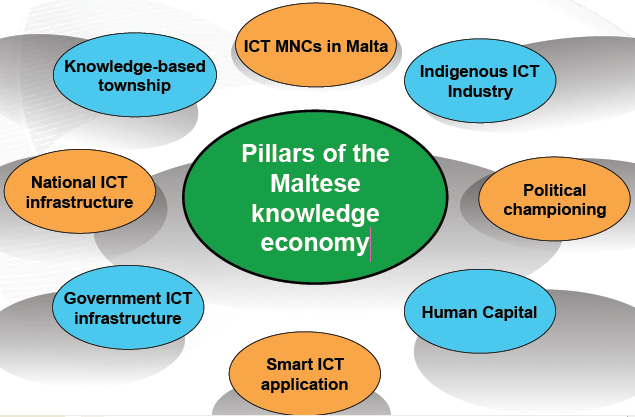
Darmanin (2011) and MITA (2008) added that the ICT policy of Malta aimed to address a 360-degree approach stands on the EU Action Plan 2010 integrating with the industrial policy of Malta and its research and technology development (RTD) strategy along with the standard practice in the international arena. The aim of Malta’s ICT strategy aimed to generate a next-generation ICT environment in the country by creating skilled human resources and putting into practice e-business e-governance, e-commerce, e-banking and where the government must provide ICT facilities in a cost-effective way to the public and private sector supported by a strong backbone of ICT. At the same time, the government has set up its national vision for ICT to provide long-term institutional support similar to the top five ICT agencies of Europe in the context of program and services quality mandated to pay a central role in the implementation of information technology adoption for public service delivery at all levels of the country attained by 2015. The strategic goals and objectives of Malta are as follows –
- Introducing an everlasting position of ‘Offices of Chief Information Officers in every ministry and their subordinate departments (Meier & Stormer 2009)
- Organizing a strong and powerful ICT professional body that would support the industry;
- Introducing the most dominant Next Generation e-governance with the master plan for Information Systems;
- Establishing the most powerful data center in the country to support education, public health service, e-Learning and e-health, and e-patient record
The Strategic Plan introduced a series of policy reforms for the country by comparison and strategic analysis at best practiced IS governance integrated with higher-value performance management, cost-reducing solution, decentralized and designating action with fewer efforts by open source solutions along with outsourcing approach (Darmanin 2011).
Digital Competence of the Human Resource for HVAs
Digital Agenda Scoreboard (2013) added that 60% of the Maltese have some extent of ICT skills and could operate a computer; the EU average of this category of people is 67%, the population of Malta has composed 24% ICT skills at an advanced and medium-range, which is almost similar to the European average. The government of Malta has engaged its highest efforts to boost its ICT skills by introducing an ICT curriculum at the school level, at the college and Universities have integrated e-learning and examination process and gaining quick progress in this regard. MEIB (2013) pointed out that the government of Malta deems ICT as a key contributor to the advancement of the national economy moves towards the digital economy vision of the country and considered ICT a strong strategic pillar for future economic growth and engaged to successful deliver ICT program to the people by integrating easy and accessible learning facilities.
MEIB (2013) explored that the has already emphasized on the e-learning program introduced in 2011 and this solution integrated most modern facilities for the teachers and students in 57 public schools and aimed to cover all the state schools with similar facilities of e-learning solution by the middle of 2013. As a result, the classrooms are automated with facilities with white digital boards, and all the teachers, students, and staff of the primary and secondary schools have the opportunities to easily access the national backbone of e-Learning solution through 10 Mbps broadband connectivity and planning to upgrade them at 50 Mbps very soon. The government also urged the private schools to drive into ICT automation very soon and the relevant ministry would provide necessary technical support to the private sector schools to introduce e-Learning solution that would ultimately facilitate the country with the skilled human resource with digital compliance.
Moreover, the government of Malta has established a bilateral agreement with the Microsoft Corporation for five years strategic partnership that encouraged Microsoft for an investment of €3 million in Malta to establish Microsoft Innovation Centre to facilitate cloud computing secure data center at every private cloud environment. On the other hand, the HP, MCAST, and MITA have reached a trilateral agreement to founding an HP Education Centre in Malta with the greater motivation to generate human resources with the necessary ICT skills for the next generation. At present, there are huge scarcities of skilled HRM for ICT function, 50% of the business organizations are facing difficulties to recruit ICT professionals, and there would be around one million unfilled vacancies all over Europe by 2015 while the NRM policy of Malta would assist to overcome such dilemmas.
Conclusion
The previous research in this area and the associated literature has tremendous gaps to provide the exact conceptual framework of Heritage Visitor Attractions, some of them emphasized heritage sites or the overall tourism industry, but none of them has enlightened on the HVAs linking their online marketing. This literature presented an in-depth analysis of the research gaps and challenges and contributed with a strong framework of HVAs for online marketing that would assist the academia and business communities in this area with a depth understanding to explore heritage resources to the global market through online marketing. This author also recognized that still there is a substantial research gap due to lack of investment, shortage of consistency with previous research, lack of coordination with the academia and industry to involve their intellectual resources and practical experiences and urge for further research to develop a strategic framework for online marketing of HVAs through systematic consultation and collaboration with the stakeholders.
Research Methodology
Introduction
The main of this chapter is to present a methodological framework to describe the online marketing of Heritage Visitor Attractions in Malta.
Qualitative Research Approach
This is an effective research approach while the topic deals with the qualitative phenomenon and there are mainly three general processes to examine qualitative data, such as content study, grounded assumption, and thematic analysis (Hussein 2010; Cohen, Manion & Morrison 2007; Boeije 2009; Trochim & Donnelly 2006; Rajendran 2001; Zikmund 2006; and Keegan 2009). However, grounded theory (the idea of constant comparative method) concentrates on inductive theory rough a process of rigorous and structured analysis (Hussein 2010; Boeije 2009; Keegan 2009; Yin 2003, Burney 2008; and Saunders, Thornhill & Lewis 2006); on the other hand, the content theory is useful to compare frequencies to statistical analysis of quantitative data. The characteristics of these theories are not truly qualitative for which this dissertation will not use content study, and grounded assumption approach as these two approaches are helpful to develop a new theory. Thematic analysis is applicable in policy research with pre-set questions to describe the case; as a result, this dissertation will apply the thematic analysis process to evaluate the data generated from the in-depth interviews; also, it will be carried through an explanatory approach since the topic relates with behavioral science to observe the underlying motives of tourists.
Quantitative Research Approach
Cohen et al. (2007) pointed out that a quantitative research method is an approach that at first put into practice in the area of natural sciences to scrutinizing natural observable fact; in the field of social sciences, this method becomes more familiar to quantify the rates and options of the respondents and represented with numerical data rather than descriptive approach.
Primary data
Primary data are new data especially collected for the specific research project (Ortega 2002; Trochim & Donnelly 2006; Rajendran 2001; Sekaran 2006; McLeod 2011, and Munhall 2011; and Veal 1997, p. 96). Such data is fresh, precise, and up-to-date (McNabb 2010; Ortega 2002; Malhotra 2009; and Rubin & Babbie 2010; and Hossain 2012). It can be generated by applying many ways, for instance, interview, survey, and observational method (Sekaran 2006; Ortega 2002; Hussein 2010; Marshall & Rossman 1999; Moustakas 1994; and Hossain 2012). In this dissertation, primary data will be collected from various selected HVAs through semi-structured interviews and quantitative self-completion surveys. The semi-structured interviews will target the management personnel of the selected HVAs; on the other hand, quantitative self-completion surveys will target the visitors.
Secondary data
Secondary Data is existing information, which the researchers collect for some reason outside the planning procedure (Malhotra 2009; Burney 2008; Rajendran 2001; Trochim & Donnelly 2006; and McNabb 2010). It saves time, effort, and costs to conduct research; also, it is a more reliable and recognized source of information (McNabb 2010; Ortega 2002; Finn, Elliott-White & Walton 2000; Sekaran 2006; and Daly & Lumley 2002). Lack of previous research in a similar topic area has generated scarcity of secondary data that would easily fit to reach the ultimate findings, thus this researcher possibly would confuse that a more refined sampling plan along with more comprehensive research design may accompany with extraordinary conclusions that the stakeholders diverse from this study. This dissertation will take data from secondary sources to gather information, such as books on the tourism industry, journal articles, and newspaper articles, report of international institutions like UNESCO, government sources, internet sources, and websites of the HVAs
Sample Size
Selected employees of the HVAs will provide a descriptive answer to the open-ended question for which the researcher will select ten respondents from five travel agencies in Malta to conduct quantitative research; on the other hand, hundred visitors will be the selected respondents for the quantitative research. Therefore, the researcher will collect primary data from a total of 110 respondents (10 employees and 100 visitors).
Several respondents for qualitative research
To conduct quantitative research, the researchers will collect data from the ten employees of five hotels near heritage sites of Malta; however, the following table gives more information-
Table 2: Respondents of qualitative research. Source: Self-generated.
Several respondents for quantitative research
In this dissertation, a total of 100 visitors will complete the structured and close-ended questionnaire. The visitors will complete the form within a few minutes as it contains only 13 questions; however, the following table provides more information about the visitors-
Table 3: Short profiles of respondents of quantitative research. Source: Self-generated.
Data Collection
To collect primary data, the researcher will design a questionnaire and send it to the tourists and the employees of HVAs; in this case, the author will conduct a direct interview with the local tourists to support the theoretical framework and to meet the objectives to assess the impact of online marketing on HVAs in Malta. The researcher will conduct a face-to-face interview to collect data from the visitors and employees by using two sets of questionnaires though it should require a long-time; so, the researcher will physically present to the visitors’ location to ask the survey questions regarding online marketing of HVAs in Malta and request them to tick answer.
Bias
Bias is a too common trend in qualitative research and it can take place in different stages of the research, such as planning, study design, data collection, and analysis (Pannucci & Wilkins 2011; Cohen et al. 2007; Munhall 2011; Malhotra 2009; and McLeod 2011). However, Cooper & Schindler (2001) and Rajendran (2001, p.1) stated that the researchers have the opportunity to select a particular target group influencing by the own attitude or viewpoint for which it is essential to define the study population. On the other hand, Marshall & Rossman (1999), Pannucci & Wilkins (2011), and Daly & Lumley (2002) stated that results of different dissertations on the same topic or related research field could be very different if the researchers considered different target population. In qualitative research, there is no fruitful solution or research approach to avoid bias; however, the researcher can use own credibilities, such as select target respondents from diversified culture, design research, and questionnaire excluding own interest and philosophy (Daly & Lumley 2002).
Questionnaire Design
The questionnaire is one of the most preferred instruments to collect data both for qualitative and quantitative research since it plays a significant role to avoid biasness and partiality in the data collection process; however, it is essential to provide a brief description before the data collection (Malhotra 2009; Miles & Huberman 1994; Sekaran 2006; Keegan 2009; and Trochim & Donnelly 2006). The validity and reliability of the data are based on the questionnaire as it addresses all the issues of previous literature and present problems (McLeod 2011; Leung 2012; and Munhall 2011). The prime goal to design a questionnaire is to assess the online marketing of Malta’s HVAs; however, it will help the visitors and employees of HVAs to respond to the questions, which will increase the response rate and gather useful information on the topic.
Data Analysis
To apply a qualitative research approach to find out the main issues from the answer of the participants, tape records and answer sheets will be checked as the staff of HVAs can provide irrelevant information regarding the impact of online to promote business or attract tourists to the tourism industry in Malta. On the other hand, the response from the open-ended questionnaire needs to evaluate without bias to represent the true picture of the online marketing on the HVAs. To assess online marketing of Heritage Visitor Attractions in Malta, collected primary data (both categorical and numerical) will be processed and analyzed using statistical tools and software such as Microsoft excel since it has the option to process and present data with an appropriate format like charts, tables, graphs and so on.
Ethics Statement
The researcher will concentrate on the provisions of national law and EU law as Malta is the member state of EU for which this country is bound to follow the directives, regulation, and treaties; on the part of ethical Issues, this research will uphold the accuracy of the data and privacy in every stage of the research process. As the primary data will be collected from various selected HVAs and visitors, the researcher will not disclose any information of the tourists and the related organizations; besides, personal data will be preserved and published by the provisions of EU treaties and Intellectual property Act, and Data Protection Act 2001of Malta. Furthermore, Addington-Hall, Bruera & Payne (2007) stated that researcher should work with integrity to present data and it is essential to give equal weight to the respondents; however, the following table gives ethical consideration-
Table 3: Ethical Consideration. Source: Self-generated.
Limitation of the research
- Heritage visitors may be reluctant to participate in the interview and they can provide an unrealistic response in the open-ended question as this paper will include both qualitative and quantitative research approach;
- All the answer from the target respondents particularly heritage visitors will not be authentic because they may have a lack of knowledge on the online marketing of heritage visitor attractions in Malta;
- Secondary data sources include many research articles and information related to the tourism industry in Malta and the future of this sector. However, most of the reports have not taken into account the impact of online marketing on this sector in the era of information technology;
- As a significant part of the data analysis chapter will be based on the qualitative and quantitative research approach, the researcher can design a questionnaire with biased questions for the heritage visitors;
- The sample size will be a medium size for which it will be difficult to analyze open-ended questions with existing word limit;
- On the other hand, the allocated deadline is so short for such a vast research area and it is another remarkable limitation for this study to attain its objectives.
- Furthermore, the schedule to collect data from heritage visitors and other survey populations will be hard for the researcher;
Summary
The prime intention of this chapter was to provide a methodological frame to serve the purpose of the present study; however, this dissertation will take data both from primary and secondary sources. Besides, primary data will be collected from visitors and HVAs; on the other hand, secondary data will be taken from books, journal articles, online resources, and different reports on the impact of online marketing on the tourism industry in Malta. From the above discussion, it can be said that both quantitative and qualitative research approaches will be considered without bias to analyze the research questions; furthermore, data will be presented taking into consideration sincerity, dependability, integrity, consistency, and validity.
Findings and Analysis
As this dissertation considers both quantitative and qualitative research approaches. The researcher will use a structured or close-ended questionnaire to collect data within a very short period; however, it should require 5-7 minutes to complete the entire form. Questionnaire 1 designs for quantitative research, which includes some general questions, then it includes questions related to online marketing, the website of the HVAs, communication and information share, e-commerce system of the service providers, the difference between the traditional approach and new marketing technology. On the other hand, the researcher will apply enclosed an unstructured or open-ended questionnaire to ask questions through direct interviews with the employees of five selected hotels near the heritage sites.
Point of view of the visitors
It has already mentioned that the researcher will collect quantitative data from 100 tourists to meet research objectives; however, among the tourists, 25 respondents are domestic visitors (Maltese), 48 tourists come from European countries (particularly from Spain), 8 visitors come from the US, 7 respondent from Asia and 15 respondents come from rest of the world. Among 100 respondents, 46 visitors are students, 7 respondents are assistants of the teachers, 5 tourists are executives, 12 visitors are businessperson, 8 visitors are job seekers, 10 tourists are employees, 5 responders are Tourist Guide, and the rest 7 respondents are journalists.
The respondents were asked to specify their name, country, continents, and gender
This question was put forward to introduce with the interviewees; however, for privacy concerns, their identities will not be exposed in this paper.
The respondents were requested to select their highest education levels
From the collected data, it is notable that 6 percent of the respondents had education levels below the senior school, 21 percent had a mere A’ level, 29 percent studied till their Bachelor degree, whereas 38 percent passed Master degree and 6 percent undertook Ph.D. or other professional qualification; however, this is illustrated in the figure below –
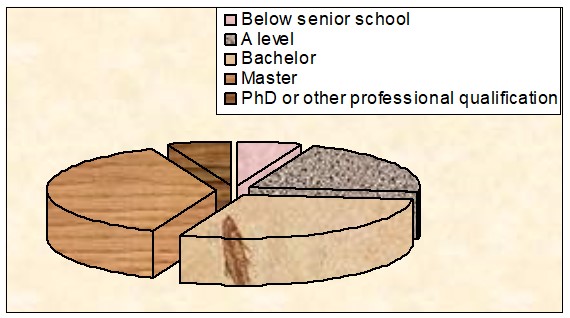
The respondents were requested to select their age groups
This was also an introductory question; however, the researcher has noted that among the respondents 22 percent aged from 15 – 25, 28 percent aged from 26 – 35, 24 percent aged from 36 – 45, 21 percent from 46 – 55, 15 percent from 56 – 65, and 22 percent from 66+.
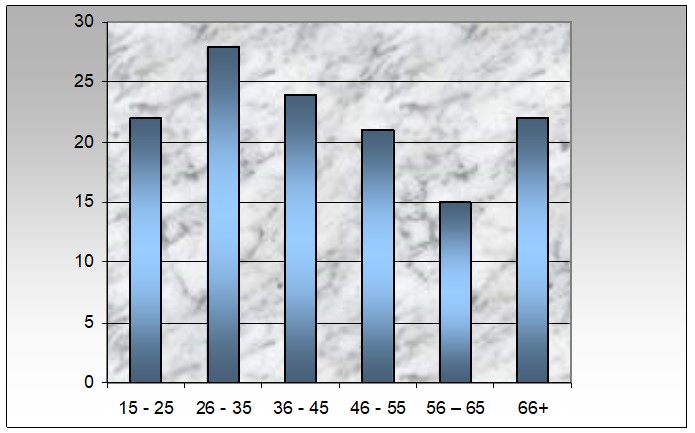
Whether the respondents visit the official website of tourism organizations of Malta before selecting a destination
The survey shows that 55 percent of people visit the official website of tourism organizations of Malta before selecting a destination and 44 percent of people do not –
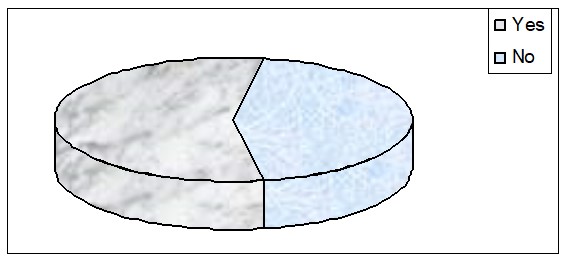
General information from visitors
Whether the respondents use social media Like Facebook, Linkedin, Wiki, and others
The researcher put forward this question to understand the extent to which the respondent’s groups are familiar with social networks. It was important because social networking, to a large scale, performs the online marketing of tourism; however, it is notable that 83 percent of people said that they use social media like Facebook, Linkedin, Wiki, and others, but 17 percent said they do not; however, the following chart illustrates this point –
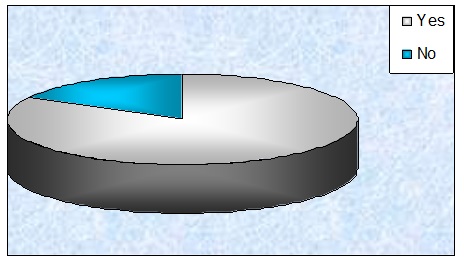
Whether the respondents use the search engine for information about destinations
It is essential to identify the exact figure of the people who use search engines for information about destinations because this will reveal the proportion of people who are likely to get involved in online marketing activities. However, while filling up the survey form, 72 percent selected yes, whereas 28 percent selected no –
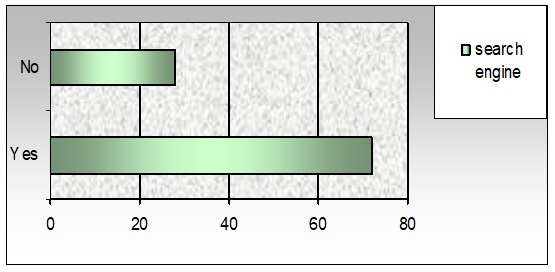
Whether the respondents use traditional methods for information about destinations
To find out the extent to which the respondents still make use of the traditional methods, this question was included in the survey form; however, after analyzing the filled forms, it was notable that 13 percent of people said that they use traditional methods for information about destinations, whereas 87 percent selected no –
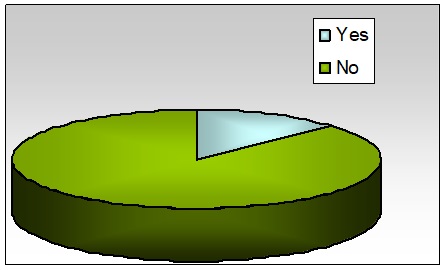
To what extent the respondents agree that the website of HVAs plays a significant role to gather information
In answering this question, the researcher has noted that the respondents have provided a mixed set of reactions. Although it was not possible to identify the reason behind this, it was noted that they tried to convey the idea that from an overall viewpoint the HVAs play a significant role to gather information. For example, about 26 percent of people strongly agreed that HVAs plays a significant role to gather information, 43 percent of people merely agreed to this, 3 percent people said no opinion, whereas 15 percent people strongly disagreed with this and 13 percent people disagreed with this argument; however, the following graph describes this in detail –

To what extent the respondents agree that HVAs should develop a user-friendly and flexible website
In this part of the questionnaire, it was the main aim to find out whether or to what extent the existing sites are developed and whether the respondent groups feel that there is a need for further development in this context. As a result, it was important to identify whether the visitors think that the HVAs should develop a user-friendly and flexible website. However, while checking through the collected data, it was noted that 52 percent of people strongly agreed that there should be user friendly and flexible website, 31 percent people agreed to this point, 2 percent people said no opinion, whereas 6 percent people strongly disagreed to this argument, and the rest 9 percent people disagreed to this proposed question. This result has been shown in the following chart in an elaborated form –

To what extent the respondents agree that HVAs should provide information in several languages
It is undoubtedly one of the most essential issues that there is a major group of visitors who are not specialized or native in the English language. In this context, it would be very difficult for Malta to attract the tourist from countries such as Greece, Italy, Germany, France, Africa, Saudi Arabia, UAE, Bangladesh, India, and so on. As a result, to aware visitors from all over the world that Malta is a country with excellent heritage attractions and that they should come here, the websites should support at least 5 different languages so that the message can be conveyed throughout the world. It was notable that 65 percent of people strongly agreed that HVAs should provide information in several languages, 24 percent people agreed to this, 5 percent people had no opinion, whereas 2 percent people strongly disagreed with this, and 4 percent people disagreed to this point; nevertheless, the following graph demonstrates the detail –

Visitors comment on website facilities
Whether the respondents agree that the website should have multimedia facilities
Multimedia facilities are one of the key success factors for any websites in today’s world; as a result, it is vital for the HVAs to integrate multimedia facilities every year, not just for aesthetic improvement of the sites, but also for attracting more and more people to visit the sites. It has been observed that most of the respondents have also pointed out that multimedia facilities are important to show people the real picture of the tourist attractions in Malta. As a result, in answering this question, 44 percent people strongly agreed that the website should have multimedia facilities, 36 percent people agreed to this, 10 percent people said no opinion, whereas 5 percent people strongly disagreed and 5 percent people disagreed to this point; this has been shown in the figure below –
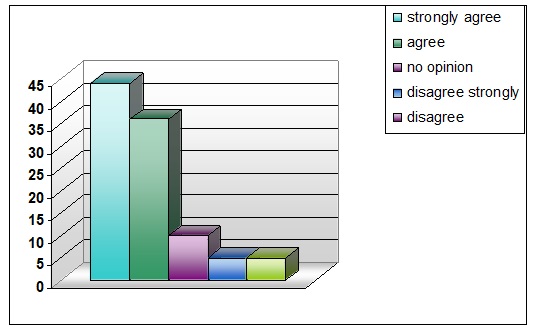
Whether the respondents agree that the website should require easy URL
Having an easy URL is very imperative because almost everyone wants that visiting any website would be simple and uncomplicated. For the concerned set of websites, it is further vital to ensure that people could easily remember the URL, and visit and revisit it repeatedly without any hassles. This would also ensure profitability for the tourism sector of Malta; also, in the survey form, the researcher noted that 66 percent of people strongly agreed that websites should require easy URL, 31 percent people agreed to this proposed question, 1 percent people had no opinion, whereas 0 percent people strongly disagreed and 2 percent people disagreed to this. The chart below illustrates this
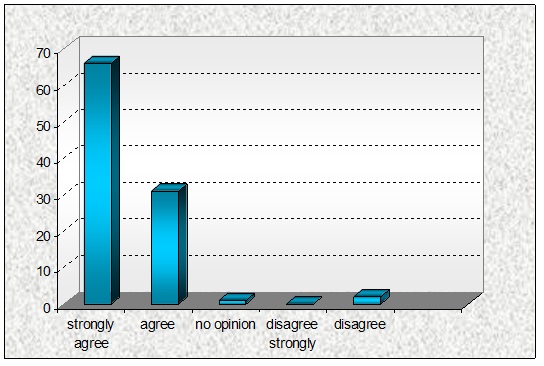
Whether the respondents agree that the website of Malta always provide correct information
The researcher put this question forward to assess the overall performance of the concerned websites of Malta. However, unfortunately, it has been noted that most of the respondents pointed out that the websites of Malta always do not provide correct information. Without correcting these problems, it would not be possible to conduct businesses flawlessly; for example, 12 percent of people strongly agreed that the websites of Malta do not always provide correct information, and 21 percent of people simply agreed to this. On the other hand, 6 percent had people no opinion, 32 percent of people strongly disagreed with this, and 29 percent people disagreed with this; as shown below –
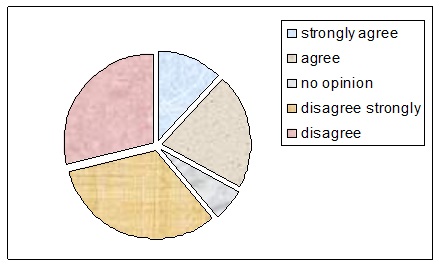
Whether the respondents agree that the website should include maps, search box, blogs, and contact information
In this part of the question, the survey results have indicated that the websites must include maps, search boxes, blogs, and contact information because this would be helpful for the visitors while searching through the pages. After conducting the entire research, and assessing the results, it was notable that 53 percent of people strongly agreed that the websites should include maps, search boxes, blogs, and contact information. On the other hand, 29 percent of people agreed to this issue, 12 percent people had no opinion, 4 percent people strongly disagreed that the websites should include maps, search box, blogs, and contact information, but 2 percent people disagreed to this point, as shown in the figure below –
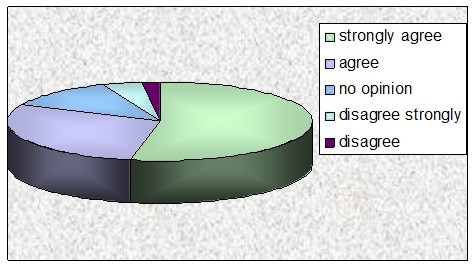
Whether the respondents agree that the websites need to provide weather information
To let the visitors know about the weather conditions of their desired destinations, including this feature in the websites is highly essential. This is because almost every tourist would like to know about the detailed climatic features of any site before physically going there, as there are matters on which they need to have preparations; for example, if the place is extremely cold, the visitors would need to have warm clothes with them while departing. As a result, the respondents have also agreed to this issue; to specify, 72 percent people strongly agreed that the website needs to provide weather information, 21 percent people agreed to this matter, 2 percent people expressed no opinion, whereas 3 percent people strongly disagreed to this, and 2 percent people disagreed to his issue. The chart below includes detailed information about this survey question –
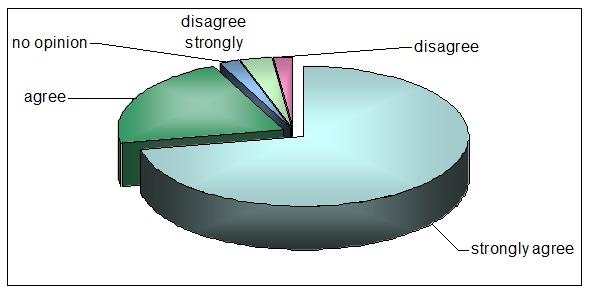
Whether the respondents agree that the website should include FAQ
This question showed a trend towards most of the people indicating that the frequently asked questions section in the webs is helpful for everyone. In this context, 68 percent of people strongly agreed that the websites should include the FAQ section, and 23 percent of people agreed to this matter. On the other hand, 1 percent of people had no opinion, whereas 2 percent of people strongly disagreed and 6 percent of people disagreed with this question, as shown in the graph below-
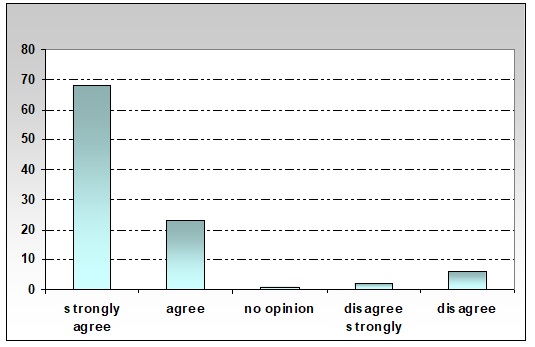
To what extent the respondents agree that the website of HVAs should provide a regular update about heritage tourist spot
There have been complaints that many visitors suffered losses and wasted their time and labor by trusting in the outdated information on the websites. To be frank, with outdated information, the scenario could be that a visitor advancing money and booking hotels, investing money in shopping, and finally facing the fact that there is a prohibition in visiting that site in that season. It is quite natural that most of the people expressed similar opinions; for example, 74 percent of people strongly agreed that the website of HVAs should provide a regular update about heritage tourist spots, and 23 percent of people agreed to this. Conversely, 1 percent of people had no opinion, 0 percent of people strongly disagreed with this, and 2 percent people disagreed with this, as shown below –
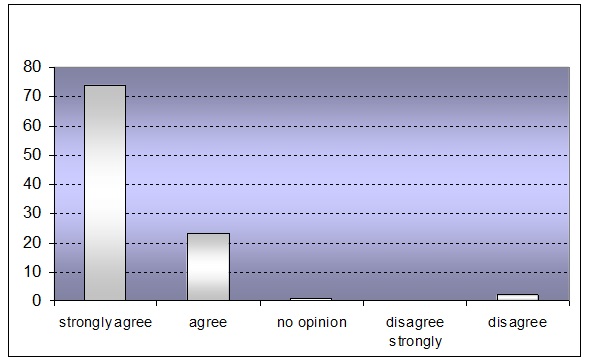
To what extent the respondents agree that the website of HVAs should provide visa information
Indeed, it would be greatly helpful for people to have visa information on the webs; and here, 63 percent of people strongly agreed that website of HVAs should provide visa information, 31 percent people agreed to this, and 2 percent people had no opinion. Conversely, 2 percent of people strongly disagreed with this and 2 percent people disagreed with this –
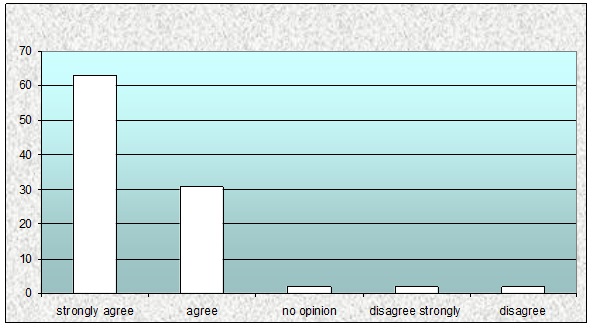
To what extent the respondents agree that the website of HVAs provide proper e-commerce services to book accommodation and transportation
Here, the respondent groups have provided a mixed set of reactions, to elaborate, 22 percent of people strongly agreed that the website of HVAs provides proper e-commerce services to book accommodation and transportation, and 35 percent people agreed to this, whereas 2 percent people had no opinion. On the other hand, 28 percent of people strongly disagreed to this point, and 13 percent of people disagreed with this; this is illustrated in the graph below-
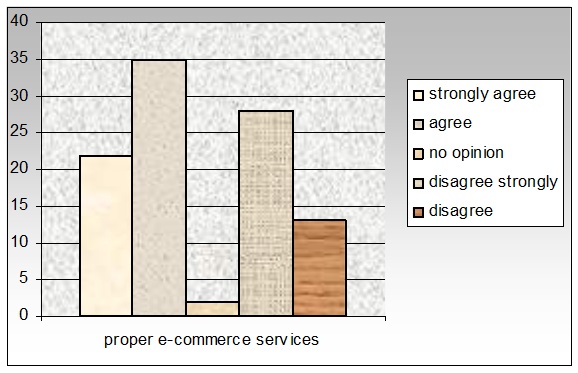
To what extent the respondents agree that the website of HVAs should develop an online marketing system
Without developing the online marketing systems, it would not be feasible for the businesses in terms of profitability to sustain, as the tourists will not find it an efficient and user-friendly system. Here, 71 percent of people strongly agreed that HVAs should develop an online marketing system, 22 percent people agreed to this, 1 percent people had no opinion, whereas 2 percent people strongly disagreed and 4 percent people disagreed with this-
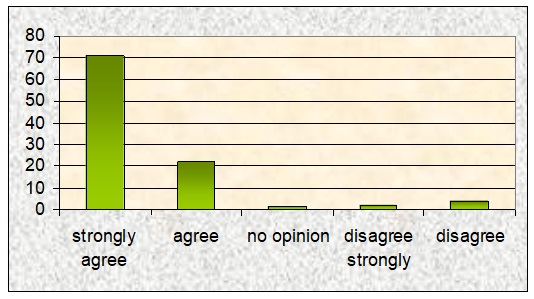
Point of view of the HVAs
Whether tourism organization have websites or not?
Yes, the employees of ten HVAs have replied that they are maintaining their website
Whether companies integrate IT and e-commerce or not?
All the respondents stated that HVAs have already adopted IT and e-commerce to some extent and the companies are trying to develop the service
Whether companies integrate Online Payment and e-invoicing?
Yes, the respondents of HVAs have stated that the companies integrate Online Payment and e-invoicing
What are the most important factors for the HVAs to attract customers through online marketing?
The employees of tourism organizations stated that there are many factors are influencing the local and international visitors to visit the heritage sites (from the archaeological and historical sites to natural sites), such as the historical background of heritage of Malta tourism, pleasant and fresh environment, smooth tourist-oriented processes and operations, security and friendly hospitality management system. The travel agencies, hotel, transportation service providers, guides, and other related organizations have tried to ensure the visitors that they are aware of the needs of the customers and perform by their needs. Therefore, the most important factors to the HVAs to attract customers through online marketing are providing the correct information about the destinations, introducing e-commerce services, promoting tourists destinations and services,
What are the key challenges to the HVAs to adopt IT and online marketing system?
To adopt IT and online marketing system, small and medium-sized companies have to face severe challenges, such as the high cost required for maintaining an e-commerce system and recruit employees, but if a very small number of customers purchase tourism products and services using the online system, then the entire project of SMEs could fail. On the other hand, respondents of large tourism organizations provided different reply and stated that implementation of IT and online market systems are a cost-effective process and it helps to increase ROI, but the problem arises to provide an update to the customers when the government changes policy regarding heritage sites. At the same time, respondents of this survey stated that foreign visitors particularly tourists who come from EU nations are highly concern about the online services; in this context, HVAs need to follow data protection acts, and Intellectual property laws.
Do you think HVAs consider the feedback of the customers and upgrade customer care?
The respondents have provided a mixed reaction in answering this part of the survey while some pointed out the inefficacy of the HVAs to study the responses of the clients and working accordingly to improve customer care services to lower the rate of grievances. However, a substantial part of this interviewed population has noted that HVAs always work on regular feedback received from the part of customers to develop services; moreover, they added that the current progress of the country in the tourism sector is also a reflection of satisfactory customer service, which persuaded an increasing number of people for tourism in Malta.
How is the significant role the HVAs play to deliver information to the tourist?
Yes, the HVAs play a significant role to deliver information to the tourist though most of the heritage sites like Megalithic Temples and Hal Saflieni Hypogeum are the other great UNESCO World Heritage Sites-WHS in Malta, which owned by the government. Therefore, the government change policy and design its schedule for which it is essential for the HVAs is to keep update properly to guide the customers. Three respondents pointed out that HVAs have a corporate social responsibility for which they aware people to conserve heritage sites; so, HVAs contribute to keeping the environment fresh through the integrated marketing campaign and other content of the websites. Seven respondents argued that more than 83% of the customers are foreigners who select their destination by searching the Internet; also, they addressed that HVAs provide instant information and updates. All the respondents have expressed that they deliver accurate information regarding products and services; moreover, they allow tourists to share their experiences about the places they have traveled.
Please, suggest your opinion to improve online marketing to attract customer
In answering this question, most of the respondents pointed out several methods by which online marketing can be improved to attract customers; they stressed finding out ways to become easily discoverable on the internet by enhancing the online presence, generating only one domain name in addition to forming communal uniqueness to refine online activities, and making online media-center as well. On the other hand, some of the interviewees focused on being energetic throughout social networks, augmenting some content sharing agendas, observing the internet status, stressing the inclusion of interactive and multimedia facilities in the respective websites, building user- friendly and tourist-oriented server, and finding out ways by which dynamic activism can be sustained in long-run for successful outcomes.
Recommendations and Conclusion
At this stage this study would make following recommendations and conclusion for the online marketing of the HVAs of Malta–
Recommendations
- This study would recommend the HVAs of Malta to boost its online marketing with greater prospect and to do so it is essential to increase the financial allocation for ICT budget of the HVAs. At present, the financial allocations are divided into two segments where 60% of the present budget spent for maintaining existing IT support and 40% for ICT automation of new projects (NAO 2011), but there is no direct allocation for the development of online marketing of HVAs. The existing budget allocations of the HVAs come from sales of ticket, private sources, local and foreign patrons and sponsors and governmental subsidies, but by increasing the operational strength and efficiency, HVAs could reduce their budgetary dependency on government and increase further investment for online marketing.
- This study would suggest for legislative reform to empower the HVAs for implication of ICT and online marketing in an independent way rather than central control and with a decentralised management. Under the Cultural Heritage Act,-2005, Heritage Malta has been empowered to act as a national agency for museums and cultural heritage operation, conservation and management by abolishing the Museums Department, such centralisation increased the influence of bureaucratic red tap that seriously hamper the advanced implication of online marketing for HVAs in Malta.
- It is essential to draw attention of the HVAs for not appointing outsider sales agent, as the marketing of ordinary products are not similar to the heritage products. For general product and services, more sales means more revenue and profit, but sales of heritage product have some limitation– every site has limited entry of the visitors, so more sales would create serious harassment to the customers to get admission at their desired sites. On the other hand, with a limited number of sales, the agent could not sustain in the business, thus, they would conduct different unethical action. To overcome these dilemmas, it is essential for HVAs to introduce fully dynamic websites backed by b2b e-Commerce model where customer would be capable of booking ticket, make secured payment, cancel the booking before 24 hours and get payback at once without any agent or middleman’s interference.
- This research has identified greater prospect of heritage attractions of Malta to develop new products from its glorious heritage resources from the 7000 years history and urged the HVAs to invest more resources for new product development in order to attain the strategic objectives of Vision 2015 and to enhance new opportunity for online marketing. The online marketing of HVAs could avail the opportunity to explore the new protective heritage sites in the web those are coming in the heritage tourism market in near future that may cultural heritage and to enrich the quality of life and society in Malta. HVAs could also keep their effort to convince the UNESCO in incorporate more heritage sites of Malta in the list of world heritage.
- It is recommended that the online marketing literature and web contents of the HVAs of Malta required to being more informative regarding historical value of the sites with positive engagement of the visitors to the cultural heritage, awareness of conservation including food, accommodation, and transportation facilities that generate comprehensive knowledge for anyone from any part of the world. The online marketing contents of the HVAs to be required fully plagiarism free and well written for keyword optimisation in order to appear at the search result.
- It recommends to increasing the number of ICT professionals with adequate skills of online marketing for the HVAs of Malta, the existing professionals pass their busy time for day to IT support to the software and hardware maintenance, and they could keep very poor efforts for online marketing. There are very few senior software managers and they are mostly involved for application software implication rather than online marketing, but there are no search engine optimisation professionals where HVAs have the opportunity to utilise SEO service from the outsourcing companies from low cost counties like India and Bangladesh. At the same time, it is essential to improve the ticketing system, at present, the HVAs are using ‘TIXPOINT’ software that is application software and not yet customised with the business pattern of HVAs, the HVAs needed to develop customised software fully integrated with the accounting system of the HVAs.
- To enhance online marketing and sales, the HVAs required to set up 24 hours dedicated call centres to support the customer all around the world, to reduce cost call canters, the HVAs could easily setup call enters in the ICT emerging market like Bangladesh and India through service agreement. Such call centres could also be used for different online marketing and blog writing in this regards, at the same time, it also suggests to conducting online marketing audit frequently.
- This study recommends the HVAs of Malta to emphasis more on the social Medias for their online marketing, as a social media facebook is very popular in Malta, but as most of the visitors come from the USA, and Europe, there are almost similar people’s alignment with Twitter; so, HVAs would simultaneously utilise both the social medias for online marketing.
- The implication of higher extents of online marketing and people’s familiarity with the e-business practice have strongly accorded with the progress of ICT education and minimum know how to operate computer, different previous research illustrated that although there are available ICT facilities, but among the micro enterprise managers and employees there are huge gaps of ICT skills and regular practice. For HVAs in Malta, it is essential to provide compulsory ICT training to every level of employees, to identify the skills gap it is also mandatory to conduct research with present position of the employee’s skills and take necessary step that would undoubtedly encourage the online marketing of HVAs pointing to cost benefit analysis.
Conclusion
This chapter of the dissertation has engaged to summarise the study attained from the theoretical discussion linking with the research findings and the researcher believe that the objectives has established by concluding the online marketing of the heritage visions attractions in Malta. The increasing awareness and demand for heritage tourism in the global market, the Maltese HVAs and as a whole tourism industry has gained a greater prospect where online marketing has provided tremendous opportunities to explore heritage products to the global market more efficiently than ever in a cost effective way. The more effectual online marketing of HVAs have strongly linked with the superior implication of ICT at the management, operation, booking, ticketing, and integrated accounting system customised with b2b, b2c and g2c e-Commerce model backed with dedicated bandwidth that facilitate the heritage tourism of Malta to drive at a higher level than ever.
Questionnaires of this paper had designed to meet research objectives for which it included questions based on theoretical framework and research aims, for instance, the employees shared their practical experience in the response of the question number 3, 4, 5, and 6 to provide recommendation for the future development. On the other hand, the response of the visitors helped to assess the real position the online marketing of Heritage Visitor Attractions in Malta and the impact of online marketing to change the perception of the customers after getting numerous facilities, such as, decision-making about destination, tour plan, and awareness about conservation of heritage site, online booking, and so on.
Finally, this conclusion would urge to conduct further research with the different e-commerce models applicable to the heritage tourism industry that would facilitate the HVAs more sophisticated way of heritage tourism management and operation including new product development as well as online marketing as an integral part of the global heritage tourism industry.
Reference List
Addington-Hall, J. M, Bruera, E & Payne, S 2007, Research methods in palliative care, Oxford University Press, Oxford.
Argyropoulou, A. Dionyssopoulou, P. Miaoulis, G 2013, Tourist Destination Marketing and Management Using Advanced ICTs Technologies.
Boeije, H 2009, Analysis in qualitative research. SAGE Publications Ltd, London.
Briguglio, L & Marie, B 1999, Sustainable Tourism in Small Islands the Case of Malta, Web.
Brookins, M 2013, The Advantages of Using Social Media Marketing.
Brown, E 2010, How implementing social media strategies (the right way) attracts customer loyalty, Web.
Brussee, R & Hekman, E 2010, Social media are highly accessible media, Web.
Buhalis, D. 1998, Strategic Use of Information Technologies in the Tourism Industry, Pearson prentice Hall, London.
Buhalis, D & Law, R 2008, ‘Progress in information technology and tourism management: 20 years on and 10 years after the Internet- The state of eTourism research’ Tourism Management, vol. 29, pp.609-623.
Buhalis, D. & Licata, M. 2002, ‘The future of eTourism intermediaries’, Tourism Management, vol.23, pp.207-220.
Burney, A 2008, Inductive & Deductive Research Approach, Web.
Cohen, L, Manion, L & Morrison, K 2007, Research Methods in Education, Routledge, New York.
Cooper, D & Schindler, P 2001, Business Research Methods, McGraw-Hill, London.
Daly, J & Lumley, J 2002, Bias in qualitative research designs. Web.
Darmanin, E 2011, National ICT Strategy and Malta Information Technology Agency, Web.
DAS 2013, Malta: Internet usage and digital skills, Web.
Debattista, M. 2011, Maltese tourism increasingly dependent on internet sales.
Delia, C & Micallef, P. E 1999, The Outgoing Tourist – Rights and Remedies under Maltese Law, Web.
Digital Agenda Scoreboard 2013. Malta: Broadband markets, Web.
Dodds, R 2007, ‘Malta’s Tourism Policy: Standing Still or Advancing towards Sustainability?’ Island Studies Journal, vol. 2, no. 1, pp. 47-66, Web.
Doherty, N. Chadwick, F & Hart, C 2003, ‘An analysis of the factors affecting the adoption of the Internet in the UK retail sector’, Journal of Business Research, vol.56, pp.888-897.
El-Gohary, H 2010, ‘E-Marketing – A literature Review from a Small Businesses perspective’, International Journal of Business and Social Science, vol. 1, no. 1.
Engel, J. F, Blackwell R. D & Kollat D. T 1995, Consumer Behaviour: The Dryden Press, New York.
ETC 2013, Malta, Web.
Evans, D & McKee, J 2011, Social Media Marketing, Willy Publishing, London.
Farsari, Y & Prastacos, P 2004, ‘Conceptualising tourism policies in north Mediterranean mass destinations’, Tourism Today: The Journal of the College of Tourism and Hotel Management, no. 4, Web.
Fedele, S 2012, Destination Marketing: Why do tourists like a destination?
Finn, M. Elliott-White, M & Walton, M 2000, Tourism and Leisure Research Methods: Data collection, Analysis and Interpretation, Pearson Education Limited, London.
Foxell, E & Trafford, A. D 2010, ‘Repositioning Malta as a cultural heritage destination”, International Journal of Culture’, Tourism and Hospitality Research, vol. 4, Iss: 2, pp.156 – 168.
Fyall, A & Garrod, B 2005, Tourism marketing: A collaborative approach, Channel View Publications, Buffalo.
Garrod, B & Wanhill, S 2012, Managing Visitor Attractions, Routledge, New York.
Ghio, A 2013, ICT Law Malta.
Gozo Media Services 2012, Heritage Malta takes out injunction against Maltaticket.com.
Grech, J, C 2004, Malta: a Permanent Process of Innovation in Tourism, Web.
Hassan, A. & Bashir, R 2012, Social Networking (Facebook): Wastage of Time or an Important Web Resource.
Heritage Malta 2007, Heritage Malta Annual Report, – 2006-2007, Web.
Hopken, W. Gretzel, U. & Law, R. 2009, Information and Communication Technologies in Tourism, Springer Wien, New York.
Hossain, M 2012, Decision Making through Primary & Secondary Data, Web.
Hoti, S, McAleer, M & Shareef, R 2005, Modelling International Tourism and Country Risk Spillovers for Cyprus and Malta, Web.
Hussein, R 2010, The Adoption of Web Based Marketing in the Travel and Tourism Industry: an Empirical Investigation in Egypt, Web.
Kanellopoulos, D, Panagopoulos, A & Psillakis, Z 2004, ‘Multimedia applications in Tourism: The case of travel plans’, The Journal of the College of Tourism and Hotel Management, no. 4, Web.
Keller, K. L 2009, Strategic Brand Management- Building, Measuring and Managing Brand Equity, Prentice Hall of India, New Delhi.
Lakhotia, G 2013, What is Brand Promotion? Web.
Leask, A & Fyall, A 2012, Managing world heritage sites 2006, Taylor & Francis, New Jersey.
Leask, A & Yeoman, I 2002, Heritage visitor attractions: An operations management perspective, Continuum, London
Magnússon, A. M 2011, The Engagement of Iceland and Malta with European Integration: Economic Incentives and Political Constraints, Web.
Malhotra, N 2009, Marketing Research- An Applied Orientation, Prentice Hall, London.
Malta Information Technology Agency 2011, National ICT Strategy and Malta Information Technology Agency, Web.
Malta Tourism Authority 2011, UNESCO World Heritage Sites.
Marshall, C & Rossman, G 1999, Designing qualitative research. SAGE Publications Ltd, London.
Martino, M. N 2011, Malta Reports on EC Engagement on Information Technology, Web.
Matlay, H 2004, Small Tourism in e-Europe, Definitional, Conceptual and Contextual Consideration in Thomas, Elsevier Science, Amsterdam.
McLeod, J 2011, Qualitative research in counseling and psychotherapy, SAGE Publications Ltd, London.
McNabb, D. E 2010, Research methods for political Science: Quantitative and qualitative approaches, Sharpe, New York.
MEIB 2013, The Maltese ICT Agenda, Web.
Meier, A. & Stormer, H 2009, eBusiness & eCommerce: Managing the Digital Value Chain, Springer-Verlag, Berlin.
Miles, M & Huberman, M 1994, Qualitative Data Analysis, Beverly Hills, CA: Sage.
Miller, R & Lammas, N 2010, ‘Social media and its implications for viral marketing’, Asia Pacific Public Relations Journal, vol. 11, Web.
Miniwatts Marketing Group 2012, Internet World Stats: Usage and Population Statistics.
MITA 2008, MITA Strategic Plan 2009-2012, Web.
Moustakas, C.E 1994, Phenomenological research methods. SAGE Publications Ltd, London.
Munhall, P. L 2011, Nursing research: a qualitative perspective, Jones & Bartlett Learning, Sudbury.
NAO 2011, Information Technology Audit Heritage Malta, Web.
Noordam, S & Smid, S 2002, Tourism on Malta, Web.
Nurick, J 2000, Heritage and tourism, Web.
O’Conner, G & O’Keefe, B 1997, ‘Viewing the web as a marketplace: the case of small companies’, Decision Support System, vol.21, pp. 171-183.
Odhiambo, C. A 2012, Social Media As A Tool Of Marketing And Creating Brand Awareness.
Ortega, M. L 2002, Managing Heritage Tourism: Challenges for the Management of Urban Heritage Cities and Attractions, Web.
Palmer, A & McCole, P 2000, ‘The role of electronic commerce in creating a virtual tourism destination marketing organization’, International Journal of Contemporary Hospitality Management, vol.12, no.3, pp.198-204.
Pannucci, C. J & Wilkins, E, G 2011, Identifying and Avoiding Bias in Research.
Pedersen, A 2002, Managing Tourism at World Heritage Sites: a Practical Manual for World Heritage Site Managers, Web.
Pigram, J.J 1980, ‘Environmental Implications of Tourism Development’, Annals of Tourism Research, vol. 7, no. 4, pp.554-582.
Pisani, D 2011, e-Government Malta’s experience 2000-2011, Web.
Poria, Y 2001, ‘Challenging the present approach to heritage tourism: is tourism to heritage places heritage tourism?’ Tourism Review, vol. 56, no. 1+2, Web.
Pradiptarini, C 2011, ‘Social Media Marketing: Measuring Its Effectiveness and Identifying the Target Market’, Journal of Undergraduate Research XIV, Web.
Prentice, R 1996, Tourism and Heritage Attractions, Routledge, London.
Pullicino, E 2002, Information Technology as a Marketing Tool, Web.
Ramboll 2010, Calypso Study On Social Tourism Malta, Web.
Raveendram, G 2006, Tourism and Information Technology IT, Web.
Richey, R & Klein, J. D 2007, Design and development research: methods, strategies, and issues, Routledge, Mahwah.
Rubin, A & Babbie, E. R 2010, Research methods for social work. Cengage Learning, Belmont.
Sandilands, T 2013, Advantages and Disadvantages of Social Media Marketing.
Saroj, P 2012, Internet Marketing in Tourism.
Saunders, M, Thornhill, A & Lewis, P 2006, Research Methods for Business Students, FT Prentice Hall, London.
SCH 2011, State of the Heritage Report 2011, Web.
Sekaran, U 2006, Research Method for Business, John Wiley & Sons, London.
Shinder, D. L. 2010, 10 ways to use social networking tools to promote your business.
Smith, P. R. & Chaffey, D 2005, E-marketing Excellence: The Heart of eBusiness, Elsevier Butterworth-Heinemann, London.
Smits, M & Mogos, S 2012, The Impact of Social Media on Business Performance, Web.
Steinrücken, T. 2010, Developing Online Marketing in Social Media for DORTMUNDtourismus.
Stelzner, M 2011, How Marketers Are Using Social Media to Grow Their Businesses, Web.
The Move Channel 2013, Malta capital ranked in top 20 UNESCO World Heritage Sites, Web.
The Times of Malta 2012, Battle of the tickets: Heritage Malta in dispute with online seller over invalid Hypogeum passes.
The Times of Malta 2013, Use of e-commerce by Maltese businesses is almost stagnant Martin Debattista.
Toolkit, M 2011, The Complete Guide to Social Media, Web.
Trochim, W. M & Donnelly, J. P 2006, The research methods knowledge base. Thomson Custom Learning, London.
UNESCO 2012, Community Development through World Heritage, Web.
Veverka, J. A 2012, Marketing Basics for Interpretive and Heritage Sites and Attractions – It’s all about the visitors.
World Economic Forum 2013, The Travel & Tourism Competitiveness Report 2013: Reducing Barriers to Economic Growth and Job Creation.
WTTC 2013, Travel & Tourism: Economic Impact 2013 – Malta, Web.
Yin, R 2003, Case Study Research: Design and Methods, Beverly Hills, CA: Sage.
Zikmund, W 2006, Business Research Methods, Harcourt Publishers, Orlando.